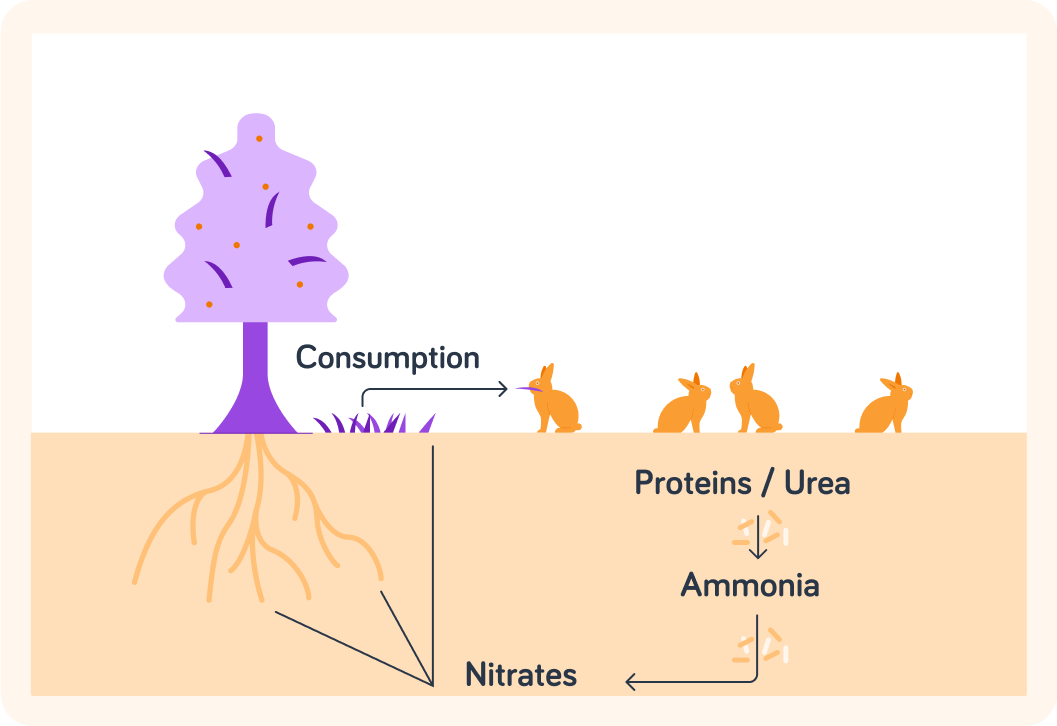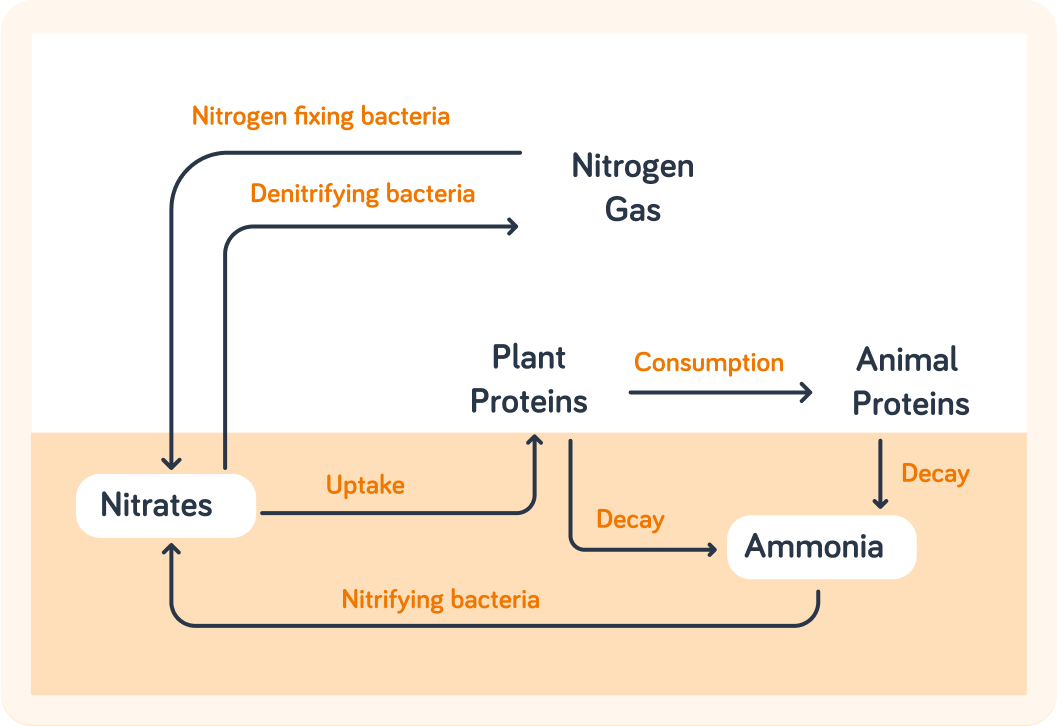YOU ARE LEARNING:
The Nitrogen Cycle

The Nitrogen Cycle
Nitrogen is an important molecule. In the soil, bacteria help to make nitrogen available for plants, so they can produce necessary molecules needed to grow. Other forms of bacteria recycle nitrogen gas back into the atmosphere.
Nitrogen compounds are essential for life. They form many of the tissues in all organisms. Nitrogen is used to make which two of the following key organic group of compounds?

You can select multiple answers
The atmosphere contains 79% nitrogen gas, N2 , but most organisms cannot make use of this massive store of nitrogen. Why do you think that is?

Because nitrogen is very unreactive as a gas, we can't really make use of the 79% of nitrogen in the atmosphere. So the nitrogen compounds that we find in organism tissues and in the soil must be recycled and reused to maintain a supply for growth and development in all ecosystems.
Nitrates are found in the soil, dissolved in water.
They are taken up by plant roots and combined with carbohydrates in the cells to make new plant proteins.

Which process in a plant obtains the carbohydrates, for example glucose?


Glucose is used to make other substances for the plant, including proteins. Plant proteins (containing nitrogen) are passed on to animals via consumption (when they eat the plants), but where do carnivores get their nitrogen rich proteins from?
A) Eating plant material B) Eating other animals C) Eating soil


Animals can't store excess proteins in the way as they can store sugars. Any proteins that aren't used are converted to urea (found in urine) and excreted from the body into the soil.
Urea and proteins that can't be used by animals enter the soil. Pick all the options below that are other sources of proteins that are returned to the soil.

You can select multiple answers
In the soil, fungi and bacteria (decomposers) convert the urea and proteins into ammonia during decay.
Ammonia is poisonous to most organisms and it is further broken down into nitrates in the soil.

What type of organism converts the ammonia to nitrates in the soil?
A) Plant roots B) Animals C) Fungi D) Bacteria


Bacteria that turn waste ammonia products from decomposers into useful nitrates have a special name.
They are called nitrifying bacteria.

What happens to these nitrates that are released by the bacteria from ammonia in the soil?
A) They are taken up by plants to make new plant proteins. B) They are taken up by animals to make new animal proteins.


This cycling of nitrogen in the soil that gets taken up by plants and transferred to animals via consumption, before bacteria release the nitrogen from their waste again in the soil represents the majority of the nitrogen cycle. However, it is also possible for nitrogen to be exchanged with the air directly.
There are bacteria that can take nitrogen gas from the air and convert it directly to nitrates NO3.
These are found both in the soil and in the roots of some plants, known as legumes (peas, clovers etc.).

So these bacteria fix nitrogen. What do you think we might call them?


However, if the soil is poorly aerated (lacking oxygen), like during a flood or poor soil management, bacteria called denitrifying bacteria can remove the oxygen from nitrates in the soil.
They use the oxygen from the nitrate molecules for respiration as there is very little oxygen in the soil. After extracting the oxygen, nitrogen gas is produced and released into the air.

What does this do to the fertility of these soils?
A) Nothing. B) It improves it. C) It decreases it.


Nitrates are essential for plant growth.
So removing the nitrates makes the soil less fertile. This is why boggy, wet soils do not make good farming land.

Although it is not shown in the diagrams, there is one non-organic process that does add huge amounts of nitrogen, in the form of nitrates, to ecosystems globally. Have a guess which one it is.

The energy contained in a bolt of lightning enables molecules in nitrogen gas to break apart and combine instead with oxygen. These newly formed compounds will dissolve in rain to form nitrates, and eventually fall back to the earth.
So, to summarise the nitrogen cycle...
Legume plants like peas and beans have nitrogen-fixing bacteria living in their roots, which are called nodules. Nitrogen-fixing bacteria are also present freely in the soil.
They are called nitrogen-fixing bacteria because they directly take nitrogen gas from the air and turn it into products the plants can use - nitrates. This keeps the plant happy to have them living in their nodules!
Herbivores will use the plant protein (made with nitrates) to build tissues.
They will excrete out what they don't use (in urine and faeces), or when they die, their tissues will decay. Decomposers get to work and release the nitrogen-containing compound ammonia from their waste products and tissues.
The ammonia in the soil from decomposers is converted by nitrifying bacteria into nitrates.
Plants which don't have handy nitrogen-fixing bacteria living in their roots (so all non-legume plants) will use nitrates present in the soil to make their proteins. Herbivores will eat these plants, and the cycle continues!
But don't forget those bacteria that need to use nitrates too sometimes!
This is when oxygen levels are low in the soil. Denitrifying bacteria will use the oxygen present in nitrates, producing nitrogen gas as a waste product, which is released into the atmosphere.
